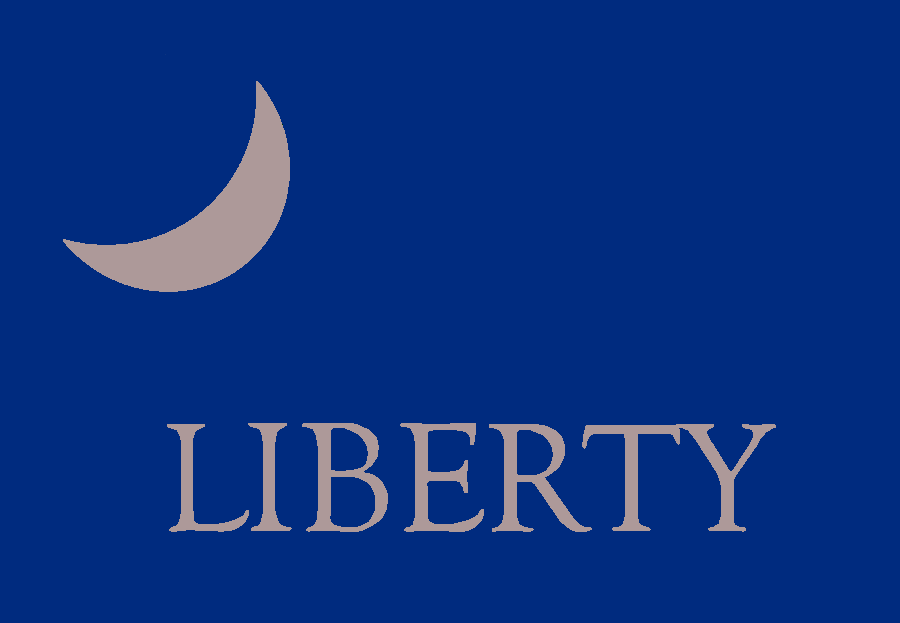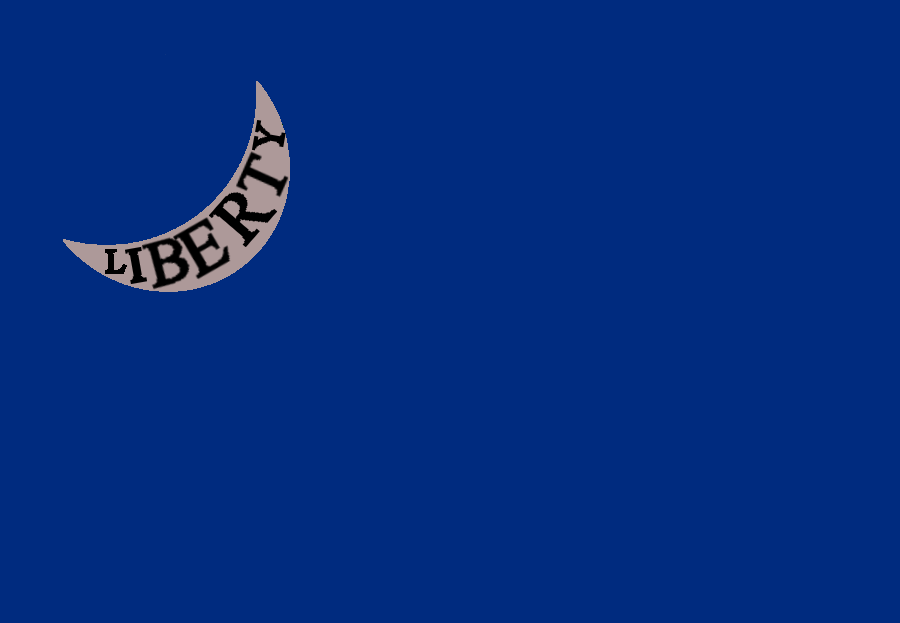


 The Fort Moultrie Liberty flag was a variation of the original Fort Johnson Flag.
The Fort Moultrie Liberty flag was a variation of the original Fort Johnson Flag.
 In January 1776, a fortification was erected by the Patriot forces on Sullivan's Island, which lay along the north shore of Charleston Bay and directly opposite Fort Johnson. The new fort was variously known as the "fort on Sulliva's Island" or "Fort Moultrie" in honor of the garrison's leader. Colonel William Moultrie did not describe the flag that was flown on the new "fort on Sullivan's Island", and some researchers have suggested that it was the same blue flag with silver crescent as flown on Fort Johnson.
In January 1776, a fortification was erected by the Patriot forces on Sullivan's Island, which lay along the north shore of Charleston Bay and directly opposite Fort Johnson. The new fort was variously known as the "fort on Sulliva's Island" or "Fort Moultrie" in honor of the garrison's leader. Colonel William Moultrie did not describe the flag that was flown on the new "fort on Sullivan's Island", and some researchers have suggested that it was the same blue flag with silver crescent as flown on Fort Johnson.
 William Henry Drayton, in his Memoirs, published in 1821, described the "Fort Sullivan" flag as: "a blue flag with a white crescent; on which was emblazoned the word 'Liberty:...'"
William Henry Drayton, in his Memoirs, published in 1821, described the "Fort Sullivan" flag as: "a blue flag with a white crescent; on which was emblazoned the word 'Liberty:...'"
 The positioning of the word: LIBERTY has been the subject of much debate. Some historians believe that it should be positioned in a semi-circle in the crescent itself, while others believe that it should be positioned on the blue field at the bottom of the flag. Colonel William Moultrie, who supposedly designed the flag, originally to be flown over Fort Johnson, described it simply as a blue field with a silver crescent in the dexter (top, left) corner. At no time did Moultrie state that the word: LIBERTY was placed anywhere on the flag. The flag flown over Fort Moultrie was only described by William Henry Drayton
The positioning of the word: LIBERTY has been the subject of much debate. Some historians believe that it should be positioned in a semi-circle in the crescent itself, while others believe that it should be positioned on the blue field at the bottom of the flag. Colonel William Moultrie, who supposedly designed the flag, originally to be flown over Fort Johnson, described it simply as a blue field with a silver crescent in the dexter (top, left) corner. At no time did Moultrie state that the word: LIBERTY was placed anywhere on the flag. The flag flown over Fort Moultrie was only described by William Henry Drayton
 The website, Swamp Fox Brigade ~ South Carolina, North Carolina, and Georgia in the Revolution displays the version of the flag with the word: LIBERTY in side the crescent and states that "Moultrie describes the word "LIBERTY" inside the crescent moon and that's good enough for us since he would have had to okay the design and making of the flag.", but Moultrie never actually described the flag flown over his namesake fortification. The website, Miner Descent ~ Carolina in the Revolution likewise states: "One iconic emblem of the battle was the flag designed by Colonel Moultrie. Commissioned by the colonial govenment, he designed a blue flag with a white crescent saying LIBERTY on it, which was flown at the fort during the battle". The image accompanying the article shows the version of the flag with the word: LIBERTY in the crescent.
The website, Swamp Fox Brigade ~ South Carolina, North Carolina, and Georgia in the Revolution displays the version of the flag with the word: LIBERTY in side the crescent and states that "Moultrie describes the word "LIBERTY" inside the crescent moon and that's good enough for us since he would have had to okay the design and making of the flag.", but Moultrie never actually described the flag flown over his namesake fortification. The website, Miner Descent ~ Carolina in the Revolution likewise states: "One iconic emblem of the battle was the flag designed by Colonel Moultrie. Commissioned by the colonial govenment, he designed a blue flag with a white crescent saying LIBERTY on it, which was flown at the fort during the battle". The image accompanying the article shows the version of the flag with the word: LIBERTY in the crescent.
 Rick Wyatt, on the website Flags Of The World states that the placing of the word LIBERTY on the bottom of the flag is wrong. His reasoning is that "My guess is that someone described it as a blue flag, with a crescent, with the word liberty on it. They put the liberty on the flag - not the crescent." Apparently Mr. Wyatt did not read Colonel William Moultrie's own memoirs to find out what the designer had to say about it.
Rick Wyatt, on the website Flags Of The World states that the placing of the word LIBERTY on the bottom of the flag is wrong. His reasoning is that "My guess is that someone described it as a blue flag, with a crescent, with the word liberty on it. They put the liberty on the flag - not the crescent." Apparently Mr. Wyatt did not read Colonel William Moultrie's own memoirs to find out what the designer had to say about it.

 It should be noted that the description by Drayton, which is transcribed on page 290 of the book, clearly has a semi-colon (not a comma) placed after the word "crescent". What this would imply is that the words preceeding the semi-colon would pertain to one thought, while the words following the semi-colon would pertain to another thought. The semi-colon is a powerful punctuation mark which separates multiple thoughts within a single sentence. It is simple English grammar. Therefore, what this implies is that the thought preceeding the semi-colon was of a "blue flag with a white crescent". The thought following the semi-colon was of the "flag" (defined before the semi-colon) "on which was emblazoned the word Liberty". If the intention was that the word LIBERTY was emblazoned on the crescent itself, then Drayton's statement would have been worded without punctuation following the word 'crescent' as: "bearing a blue flag with a white crescent on which was emblazoned the word Liberty".
It should be noted that the description by Drayton, which is transcribed on page 290 of the book, clearly has a semi-colon (not a comma) placed after the word "crescent". What this would imply is that the words preceeding the semi-colon would pertain to one thought, while the words following the semi-colon would pertain to another thought. The semi-colon is a powerful punctuation mark which separates multiple thoughts within a single sentence. It is simple English grammar. Therefore, what this implies is that the thought preceeding the semi-colon was of a "blue flag with a white crescent". The thought following the semi-colon was of the "flag" (defined before the semi-colon) "on which was emblazoned the word Liberty". If the intention was that the word LIBERTY was emblazoned on the crescent itself, then Drayton's statement would have been worded without punctuation following the word 'crescent' as: "bearing a blue flag with a white crescent on which was emblazoned the word Liberty".

